DB function in Excel is a valuable tool for calculating depreciation using the declining balance method. By leveraging this function, you can efficiently track asset depreciation over time, providing accurate financial insights and facilitating better budgeting and forecasting. Whether you’re managing business assets or personal investments, the DB function in Excel helps streamline your accounting processes, ensuring compliance with financial reporting standards. Mastering this function enables you to stay organized, minimize errors, and make informed financial decisions with confidence. Incorporate the DB function in Excel to enhance your financial analysis and asset management strategies.
- What is DB function?
- Syntax of DB function.
- How to use DB function in excel?
- Apply DB Function Without Month Value to Calculate the Depreciation Cost of the Asset.
- Why DB Function returns Num! Error ?
- Some things to remember about DB function.
1.What is DB function?
To determine depreciation expense for an asset over a period, Excel’s DB function uses the declining balance method. Based on the asset’s original cost, residual value, and useful life over time, this approach assumes a steady decline in its value throughout each period.
2. Syntax of DB function.
Excel’s DB function, which employs the double declining balance method, is particularly useful in accounting and financial analysis to calculate depreciation of assets over their life expectancy.
This method assumes that the asset loses value more and more rapidly.
This means that the asset loses value faster during the first few years of its life.
Details of the parameters and how they work are as follows.
=DB(cost, salvage, life, period, [month])
Cost (required): Its value represents the cost of buying that asset. This is the value of the asset at the beginning of its useful life.
Salvage Value (Required): This is the estimated value of an asset at the end of its useful life.
This is the expected value if the asset were fully depreciated.
Useful Life (Required): Its value denotes how many periods the asset has been depreciated. The standard way to express this is in years, although the unit can be categorized differently based on the method of measuring the asset’s useful life.
Period (required): Depreciation is calculated for a particular period, which is known as Period.
This can be any period within the asset’s life, such as year 1, year 2, etc.
Month (optional): The quantity of months within a first year is determined by this parameter.
In case of omission, Excel’s default setting is 12 months. In case the asset’s first year is not complete, this applies to you, and you can adjust the depreciation accordingly.
3. How to use DB function in excel?
Step 1: Assume that the cost, Salvage value, useful life, and duration (1 to 4) are shown in the table. The month is 6. Calculate the depreciation of the asset for each period? Insert the Data into the Excel sheet.
Enter the Data here

Step 2: Now, add the column from A7:E7 for getting the result of the depreciation cost there.
The columns have been added here.
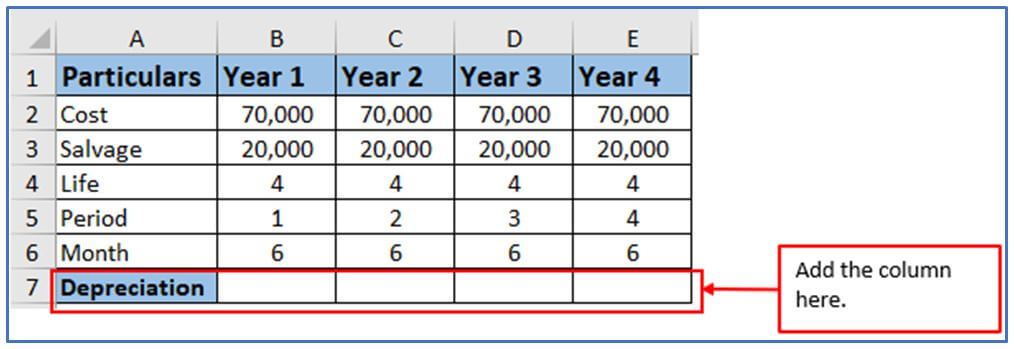
Step 3: Now, insert the formula according to your information column.
Formula: =DB(B2,B3,B4,B5,B6)
Use the formula below.
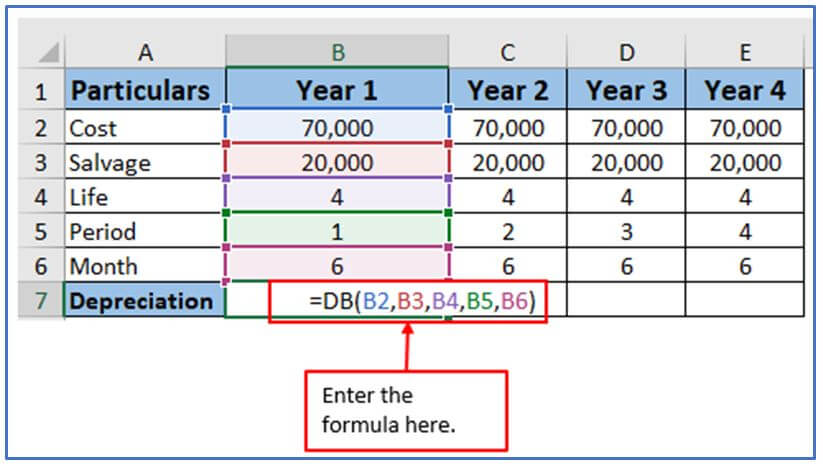
Step 4: After entering the formula Press enter.
Here is the result of Year 1, Depreciation cost.
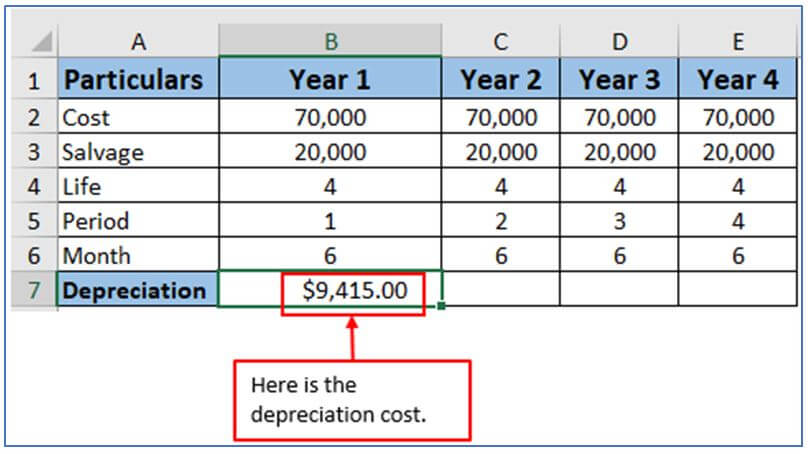
Step 5: Now to get all the year’s depreciation costs use the same formula from Step-3 or Drag-down the cursor from B7.
Here are all the years depreciation costs.

4. Apply DB Function Without Month Value to Calculate the Depreciation Cost of the Asset.
Step 1: First, take some information and put them into Excel.
Where,
Salvage value, useful life, and duration (1 to 5).
The month is omitted.
Entered the above data into an Excel sheet.

Step 2: Now, add the column from A6:F6 to get the results.
Add the column here.

Step 3: Use the formula now.
The formula is: =DB(B2,B3,B4,B5)
Place the formula below.
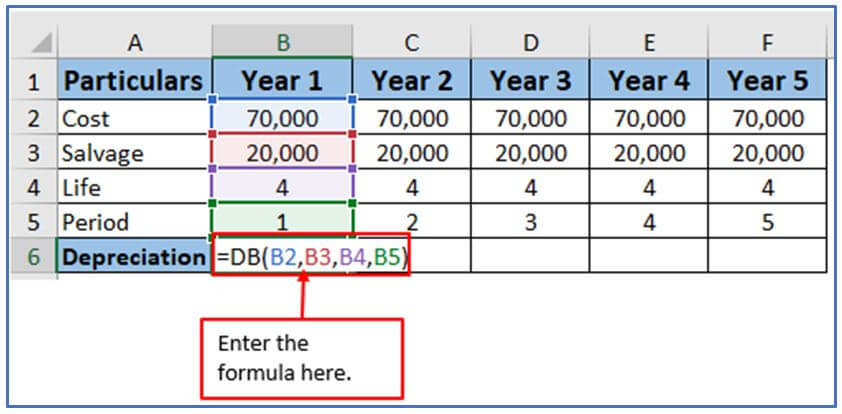
Step 4: When the formula is set, press enter and the result will come out.
Here is the depreciation cost without month:

Step 5: Now to get all the year’s depreciation costs without months use the same formula from Step-3 or Drag-down the cursor from B7.
Here are all the year’s depreciation costs without month.

5. Why DB Function returns Num! Error ?
Step 1: Here calculates the five-year depreciation expense for the asset based on the values shown in the table. Put this data in your excel as written.
Place the information here you can see below.

Step 2: To get the result add the columns from A6:F6.
You can see below the columns have been added here.

Step 3: Now you can use this basic formula to calculate the depreciation costs.
=DB(B2,B3,B4,B5,B6)
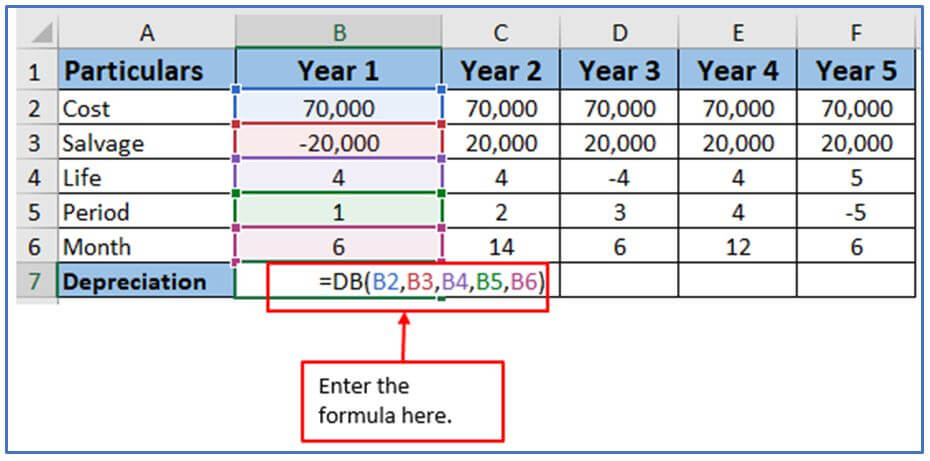
Step 4: After entering the formula, you need to press Enter. After pressing Enter you will get the results as shown below.
The result is error in cell B7 is due to the negative Salvage value in B3.
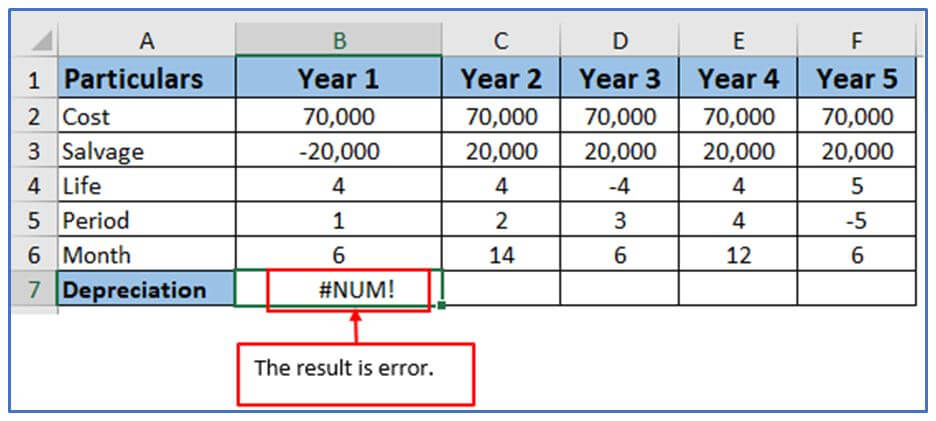
Step 5: Here, Use the same formula for the rest of the years or drag-down the cursor from B7 to F7. #NUM errors appear in various scenarios.
All the year’s results are error.
C7 This is an error because the month value is greater than 12.
The error occurs in D7 because the duration value is less than 0.
In E7, the period is longer than the asset’s life and the months are specified as 12.
A negative number of period causes #NUM error in F7.

6. Some things to remember about DB function.
- #Value!Error – Occurs when the specified argument is not a number.
- #NUM!Error – Occurs when: The specified cost or remaining arguments is less than zero.
- The specified lifetime or period argument is less than or equal to zero.
- The specified month argument is less than or equal to 0 or greater than 12.
- The month argument was omitted because the specified period argument is greater than the lifetime argument.
Specified period is greater than Life +1. For example, suppose an asset has a useful life of 5 years and you specify 6 years and 12 months as the month argument in the period argument.
Application of DB function in Excel
- Depreciation Calculation: The DB function in Excel calculates asset depreciation using the declining balance method, which allocates more depreciation in the earlier years.
- Financial Reporting: Use the DB function to create accurate depreciation schedules for financial statements, ensuring compliance with accounting standards.
- Budgeting: Incorporate the DB function into your budgets to forecast asset value reduction and plan for future capital expenditures.
- Asset Management: Track the depreciation of fixed assets like machinery, vehicles, or equipment, aiding in asset management and maintenance planning.
- Tax Planning: Use the DB function to estimate depreciation for tax purposes, helping optimize deductions and reduce taxable income.
- Investment Evaluation: Apply the DB function to assess how depreciation impacts asset value over time, influencing investment decisions and ROI calculations.
You may be interested:
